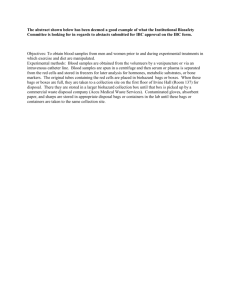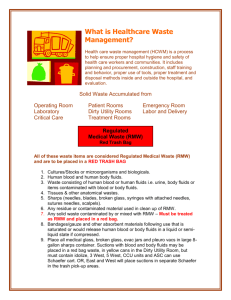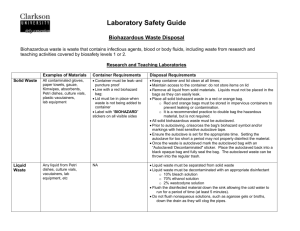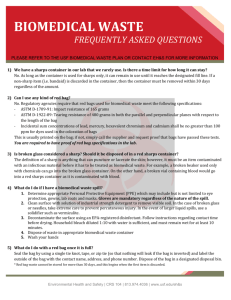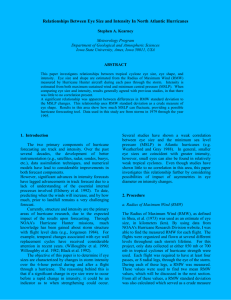doc - Cornell University College of Human Ecology
advertisement
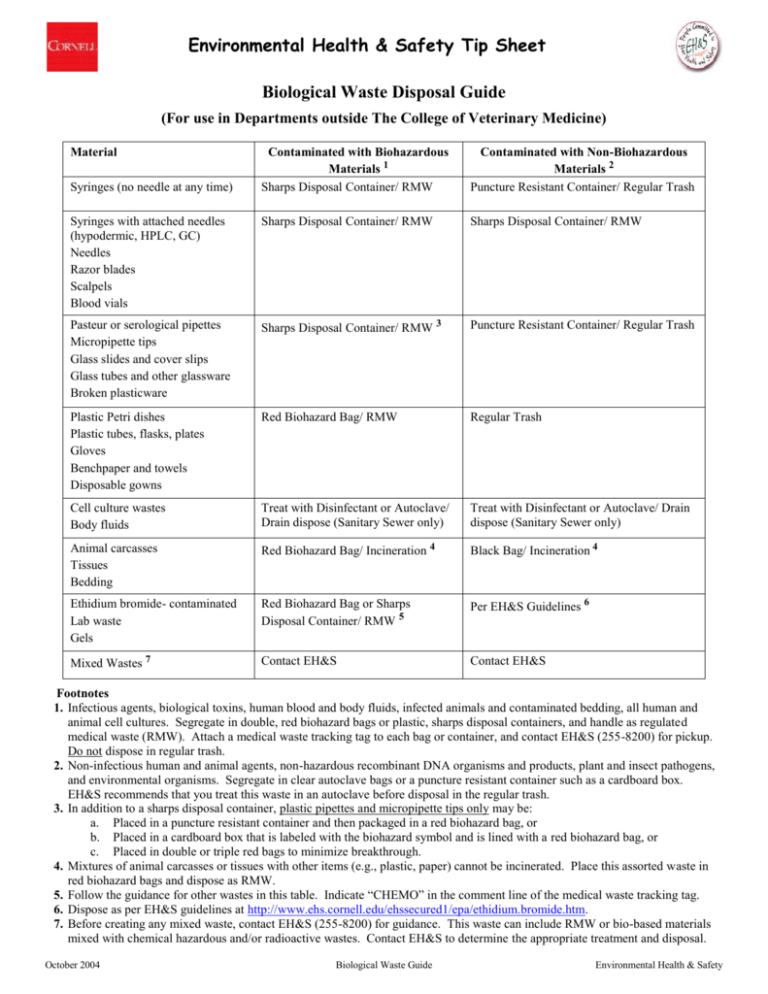
Environmental Health & Safety Tip Sheet Biological Waste Disposal Guide (For use in Departments outside The College of Veterinary Medicine) Material Contaminated with Biohazardous Materials 1 Sharps Disposal Container/ RMW Contaminated with Non-Biohazardous Materials 2 Puncture Resistant Container/ Regular Trash Syringes with attached needles (hypodermic, HPLC, GC) Needles Razor blades Scalpels Blood vials Sharps Disposal Container/ RMW Sharps Disposal Container/ RMW Pasteur or serological pipettes Micropipette tips Glass slides and cover slips Glass tubes and other glassware Broken plasticware Sharps Disposal Container/ RMW 3 Puncture Resistant Container/ Regular Trash Plastic Petri dishes Plastic tubes, flasks, plates Gloves Benchpaper and towels Disposable gowns Red Biohazard Bag/ RMW Regular Trash Cell culture wastes Body fluids Treat with Disinfectant or Autoclave/ Drain dispose (Sanitary Sewer only) Treat with Disinfectant or Autoclave/ Drain dispose (Sanitary Sewer only) Animal carcasses Tissues Bedding Red Biohazard Bag/ Incineration 4 Black Bag/ Incineration 4 Ethidium bromide- contaminated Lab waste Gels Red Biohazard Bag or Sharps Disposal Container/ RMW 5 Per EH&S Guidelines 6 Mixed Wastes 7 Contact EH&S Contact EH&S Syringes (no needle at any time) Footnotes 1. Infectious agents, biological toxins, human blood and body fluids, infected animals and contaminated bedding, all human and animal cell cultures. Segregate in double, red biohazard bags or plastic, sharps disposal containers, and handle as regulated medical waste (RMW). Attach a medical waste tracking tag to each bag or container, and contact EH&S (255-8200) for pickup. Do not dispose in regular trash. 2. Non-infectious human and animal agents, non-hazardous recombinant DNA organisms and products, plant and insect pathogens, and environmental organisms. Segregate in clear autoclave bags or a puncture resistant container such as a cardboard box. EH&S recommends that you treat this waste in an autoclave before disposal in the regular trash. 3. In addition to a sharps disposal container, plastic pipettes and micropipette tips only may be: a. Placed in a puncture resistant container and then packaged in a red biohazard bag, or b. Placed in a cardboard box that is labeled with the biohazard symbol and is lined with a red biohazard bag, or c. Placed in double or triple red bags to minimize breakthrough. 4. Mixtures of animal carcasses or tissues with other items (e.g., plastic, paper) cannot be incinerated. Place this assorted waste in red biohazard bags and dispose as RMW. 5. Follow the guidance for other wastes in this table. Indicate “CHEMO” in the comment line of the medical waste tracking tag. 6. Dispose as per EH&S guidelines at http://www.ehs.cornell.edu/ehssecured1/epa/ethidium.bromide.htm. 7. Before creating any mixed waste, contact EH&S (255-8200) for guidance. This waste can include RMW or bio-based materials mixed with chemical hazardous and/or radioactive wastes. Contact EH&S to determine the appropriate treatment and disposal. October 2004 Biological Waste Guide Environmental Health & Safety Environmental Health & Safety Tip Sheet PROCEDURES FOR REGULATED MEDICAL WASTE REMOVAL AT CORNELL UNIVERSIRY (non-vet school) 1. Containers 1.1 Sharps containers must be approved rigid, leak proof and puncture-resistant (cardboard containers are no-longer allowed). 1.2 Red biohazard bags must be red in color and have the universal biohazard symbol on them. (EH&S recommends VWR cat. no. 11215-826 RMW bag) 2. Packing procedures 2.1 Sharps shall be placed in approved containers. The containers must be sealed as to prevent release of material and injury to personnel. Any bags used to line containers must be tucked inside and no needles can be sticking threw the locking enclosure. Containers must also be in good condition with no holes or cracks and hold any liquid when standing upright. 2.2 Dry RMW (excluding sharps) must be double bagged in red biohazard bags. Waste must be rebagged after autoclaving with a fresh biohazard bag. Bags cannot be leaking or have holes and cannot contain loose pipettes. 2.2.1 Pipettes must be placed in cardboard boxes within biohazard bags, packaged in biohazard burn boxes or bundled together by tape. 2.2.2 Bags must be sealed tightly and not come open during handling. It is best to use twist ties, plastic cable ties or sturdy tape(time tape is not sturdy). 2.3 Biohazard burn boxes must be lined with a plastic bag. The bag must be closed and the lid fastened with sturdy tape (duct tape or packing tape). 2.4 Liquid RMW can be drain disposed after autoclaving or after being treated with a 10-fold bleach solution for 10-15 minutes. 2.5 Carcasses and animal tissues that are non-infectious must be bagged in non-biohazard bags. The bags cannot be leaking or contain holes. Bags cannot contain excess plastics, gloves or pads. Black trash bags are recommended. 3. Waste Removal 3.1 All items needing removal must be tagged. The top two lines of the tag must be completed and the appropriate box checked. The tag must be securely fastened to the item, stapling works best. 3.2 For labs that are not on a regular schedule, you must contact EH&S to request a RMW pick-up. 3.2.1 RMW pick-up is performed every Thursday morning. Request must be made to EH&S by 4:00pm Wednesday. 3.2.2 RMW pick-ups can be requested by phone 255-8200 or on the Web at www.ehs.cornell.edu under “Forms and Documents”. October 2004 Biological Waste Guide Environmental Health & Safety
